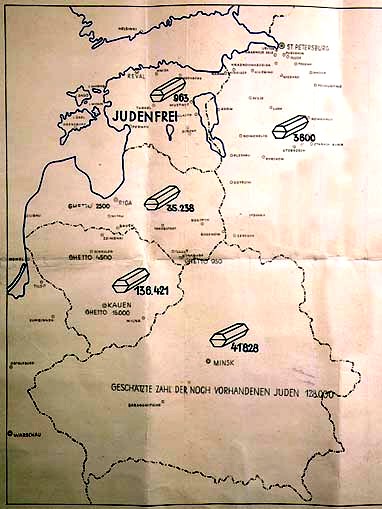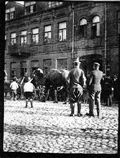VILNA HISTORY
Vilna, Wilno, Vilnius, ...
Wilno ... or Vilnius ...is the capital of the present day Lithuania and one of the country's oldest cities. It stretches along both banks of the fast flowing Neris River, and is set among hills and pine forests. Wilno is very old city.
The WELLER ’s came from Kovno (now Kaunas) and the ZEMSER’s from Vilna (now Vilnius). Both places are currently in Lithuania although in the past, they were in the Russian or Polish Empires, depending upon political boundaries of the time.
The pre-World War II numbers are staggering: Vilnius' Jewish population was nearly 100,000, about forty-five percent of the city's total. Lithuania was strewn with some two hundred Jewish communities sustaining the lives and livelihoods of about 240,000 people. Vilnius had 105 synagogues and prayer houses. There were six daily Jewish newspapers. Yiddish was the language of choice. Indeed, the city was aptly named "The Jerusalem of Lithuania".
The post-war numbers are horrifying: Only 24,000 Jews survived. Ninety (90) percent of Lithuania's Jews were murdered. Vilnius' Jewish population today is 5,000, a mere five percent of what it once was. The country is home to 6,500 Jews, some 200 of whom are Holocaust survivors. Most of the two hundred pre-war communities were decimated, wiped off the map entirely. There is only one Jewish newspaper. Few people speak Yiddish anymore. Today, there remains exactly one synagogue in Vilnius. No other Jewish community in Nazi-occupied Europe was so comprehensively destroyed.
This Nazi map of Jews Murdered in Kovno in 1943 depicts the horror:

(from Stahlecker's report entitled "Jewish Executions Carried Out by Einsatzgruppe A" and stamped "Secret Reich Matter." ) It shows the number of Jews executed in the Baltic States and Belorussia in 1941. The legend at the bottom states that "the estimated number of Jews still on hand is 128,000." Credit: Latvian State Historical Archives, Riga
History of Vilna
The honour for founding Wilno is justly given to Gediminas (Lithuanian Duke) in 1323. Having declared Wilno his "Royal Town", Gediminas created the conditions for its subsequent growth as well as the political, economical and cultural center of Lithuania.
Following the craftsmen in other European towns at the end of the 15th century, Wilno craftsmen began to join together by professions into guilds. Many Catholic churches and monasteries appeared in the town. Stone buildings sprang up inside the Lower Castle. The new Cathedral was among them. Crafts and trade continued to develop in the 16th century. Many beautiful new buildings in the late Gothic and Renaissance style appeared in the town. The most significant event in the cultural life of 16th century Lithuania was the founding of the Wilno Academy in 1579, which was endowed with the rights and privileges of a university. In 1795 Wilno became the center of a new gubernia consisting of the lands annexed to the Russian Empire. A number of new Classical style buildings were built, including the Cathedral, which had been reconstructed at the end of the 18th century. In 1860, a railway line, the first in Lithuania, crossed Wilno and connected the town with St. Petersburg, Russia and Warsaw, Poland.
During World War I Wilno was occupied by the Kaiser's troops for three and a half years. On 16th February, 1918, the Lithuanian Council in Wilno proclaimed an independent Lithuanian Republic.
Jews Have Lived in Lithuania Since the 14th Century
They came at the invitation of the Grand Dukes Augustus II and Augustus III, who had recognized the utility of the merchants, artisans, and traders as an integral component in the development of the nation. Jews also played important roles in diplomatic missions and defense. Over the centuries, however, the Jewish community rode a volatile rollercoaster of turmoil and peace. Throughout, the Jews of Lithuania were resilient, managing to refine a culture steeped with history, tradition, education, and family.
Jews were particularly entrenched in Lithuanian society at the outset of the 20th century, and no place was more important than Vilnius, an Ir ha-em, or a Great Mother City. Without question, it was the axis of the Lithuanian Jewish world. Renowned scientists, teachers, writers, sculptors, and musicians made their homes here. Jewish secular and religious institutions flourished, including Der Yiddisher Visenshaftlicher Institut in the 1920s and 1930s, which published countless scientific works. Vilnius was selected to be its headquarters. Albert Einstein, Sigmund Freud and Marc Chagall were honorary members of the board.
From the 16th century, the yeshivot developed a particular method of teaching known to this day as the "Lithuanian Yeshivot." In the 18th century, The Great Gaon of Vilnius, Elijah ben Shlomo Zalman, attained guru status, esteemed as one of the world's greatest thinkers and authorities on Torah and Talmud.
In the 19th century, Vilnius was the center of the Jewish Labor Movement led by the Bund, or socialist party, which strove to secure equal civil and political rights, including better than squalid living conditions. The party also educated the working class in self-defense and how to resist fascism.
By the start of the 20th century, a Jewish renaissance was rising. In addition to the scads of synagogues, libraries, schools, theatres, museums, medical facilities, scientific institutions, and publishing houses were established. Yiddish was soundly the lingua franca. Moreover, it was regarded as a secular culture and therefore an alternative to traditional Judaism.
Built in 1903, the Torat Hakodesh Synagogue survived the war because the Nazis used the edifice as a medical store. It's a rather grand, modern-looking synagogue capped by a depiction of the tablets of the Ten Commandments. "A house of prayer is a holy place for all peoples" is inscribed in Hebrew above the door. To the right of the bimah, the floorboards had been ripped up for some repairs. The long, upright pew-like benches appeared worn. The dull lighting exuded a jaded ambience (spruced up considerably by the vigor of the thirteen over-70 male voices in the congregation). But hidden beneath that veil of murk was a bimah of considerable decor and ornamentation.
The first synagogue in Vilnius is said to date to 1440, and came to be known simply as The Old Synagogue. The streets adjacent to the building quickly became the center of the Jewish quarter; the road running directly to the synagogue was dubbed Di Yiddishe Gas, or Jewish Street. Today, Zydu Gavte, or Jewish Street, and Gaono, named for the Gaon, remain. There are few other reminders of this area left save for a few derelict buildings situated on prime real estate in the heart of the Old City. In 1663, a new stone synagogue replaced the old wooden one and came to be called the Great Synagogue. Its interior was said to be opulently adorned. In 1944, the building was heavily damaged and was completely razed following the war. The light of the community, it seemed, had been quashed with the Great Synagogue.
The Holocaust
The first shootings of Jews in Vilnius occurred on 4 July 1941. On the same date the Germans ordered the establishment of a Judenrat (Jewish Council). An execution site was created at the village of Ponary, 10 km from Vilnius. The mass extermination of the Jewish people in Vilnius began at the moment when district commissar Hans Christian Hingst arrived, together with the "expert on Jewish questions", Franz Murer. Between the time of the German occupation of the city and the creation of the ghettos on 6 September 1941, 20,000 Jews either vanished or were killed outright. By the end of 1941 the murdered Jews of Ponary numbered at least 48,000, the majority of them from Vilnius .
As the reports of Einsatzgruppe A testify, the rapid annihilation of the Jews of Lithuania was only made possible because of the eager participation of the local population. The German invasion found the Russians militarily unprepared and the civilian population disoriented and demoralized. Exploiting the superstitious anti-Semitic prejudices of the local population and their hatred of the Soviets, the Germans utilized these willing collaborators to round up and kill the Jews. In Vilnius, Lithuanians roamed the streets, capturing Jewish men and hauling them away, purportedly for work. The activities of these Lithuanian auxiliaries were so in tune with German plans that by the end of July 1941, twenty local police battalions were formed. Under the supervision of Franz Lechthaler, commander of the 11th Battalion of the German reserve police, about 8,400 Lithuanian volunteers were charged with the murder of local Jews. By the end of 1941, when most Lithuanian Jews had been killed, some of these battalions were sent to Byelorussia and Poland, where they perpetrated killings in towns, ghettos and camps, including Treblinka and Majdanek, as well as taking part in the destruction of the Warsaw ghetto.
By 25 September 1943 only 2,000 Jews officially remained in Vilnius, in four small labour camps. More than 1,000 were in hiding inside the ghetto. Those in hiding were gradually hunted down and executed. Those permitted to live continued to work at the Kailis and HKP factories until 2 July 1944 . Then on the eve of liberation, 1,800 of them were taken to Ponary and shot. Less than 200 of the workers remained in hiding until the Red Army entered Vilnius on 13 July 1944. Between 2,000 and 3,000 of the original 57,000 Jewish inhabitants of Vilnius survived, either in hiding, with the partisans, or in camps in Germany and Estonia, a mortality rate of approximately 95% - almost exactly corresponding with that of Lithuania as a whole.
On May 8, 1990, shortly following Lithuania's regained independence, the Supreme Council of Lithuania issued an official "Statement on the Jews." It said, "[We] unconditionally denounce the genocide on behalf of the Lithuanian people...Crimes against the Jews in Lithuania and elsewhere could not be justified by any means and that immortalizing the Holocaust victims’ memory was the concern of the Lithuanian State."
The 2001 census indicated that the population of Vilnius was 542,287, of whom 0.5% or about 2,700 were Jews.
DISCLAIMER: THIS IS WORK IN PROGRESS. WE ARE NOT SURE THIS INFORMATION IS ENTIRELY CORRECT, AND WE KNOW IT IS INCOMPLETE. |



